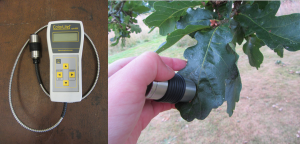Introduction to the recording of autumn phenology on Whiteknights campus
Whiteknights campus plays host to a wide range of phenological events throughout the year, this is due to the highly diversity collection of organisms present within the campus (as highlighted by the recent Biodiversity Blitz).
Perhaps one of the most iconic phenological events through the autumn is the changing colour of leaves; this can be seen on many of the trees within the Whiteknights campus. The campus has a long history associated with the trees present on campus. It was the home of Marquis of Blandford during the 18th century who created vast elaborate gardens and collected trees from around the world. As a result there is a huge range of trees found on campus, some of which are considered key veteran trees and monitored by the Wokingham District Veteran Tree Association.
Recording autumn phenology is seen as a highly important activity by many phenological networks and is a commonly recorded season; one reason for this is that many of the events can be easily recorded through visual observations, making these events ideal for recording networks that rely on recording by volunteers. One such event often recorded is leaf colouration through the autumn.
Autumn leaf colouring visual marks the start of senescence in many deciduous tree species and the end of the growing season. Species vary greatly in the time at which leaf colouration begins, as well as the rate of senescence. This makes recording this phenological event all the more important. For that reason it was decided that autumn leaf colour and leaf fall would be recorded for eight species of trees found within Whiteknights campus, in particular within the Harris Garden. The species that were chosen for recording were: beech (Fagus sylvatica), oak (Quercus robur), hazel (Corylus avellana), sycamore (Acer pseudoplatanus), silver birch (Betula pendula), horse chestnut (Aesculus hippocastanum), ash (Fraxinus excelsior) and two varieties of flowering cherry (Prunus serrulata ‘Ukon’ and Prunus serrulata ‘Ojochin’).
During 2012, eight species were recorded on a weekly basis from the start of September through to the end of December. Every week three methods of recording leaf fall and leaf colour were conducted, with the aim of comparing the results found from the three recording methods to find the most accurate and reliable method for use in subsequent years.

A colorimeter was used to record the colour of a random selection of leaves on each tree on a weekly basis
The three methods of recording used were: 1) visually recording the percentage of leaves that had coloured and the percentage of the leaves present on the tree; 2) photographs were taken looking up into the tree canopy and analysed using image analysis software (ImageJ) to show the proportion of red:green:blue pixels present within the images ; 3) a colorimeter was used to record the colour of the leaves present on the tree.

Images captured on a weekly basis for an oak tree over the sampling period to be analysed using ImageJ
Having considered the results from 2012 and having gathered feedback for each of the recording methods, it has been decided that this year visual observations and image analysis (with ImageJ) will be continued.
This year, fewer species will be recorded, but with more replicates for increased statistical precision. The species that have been chosen for recording this year are: beech (Fagus sylvatica), oak (Quercus robur), hazel (Corylus avellana) and horse chestnut (Aesculus hippocastanum).
Stay tuned to find out what happens this year!
